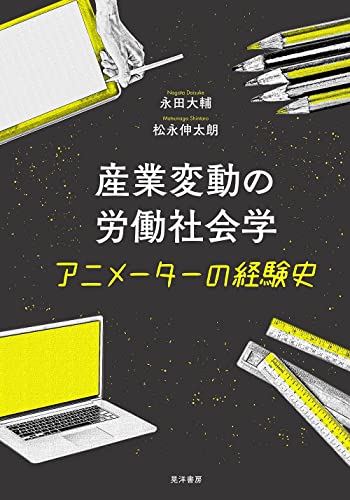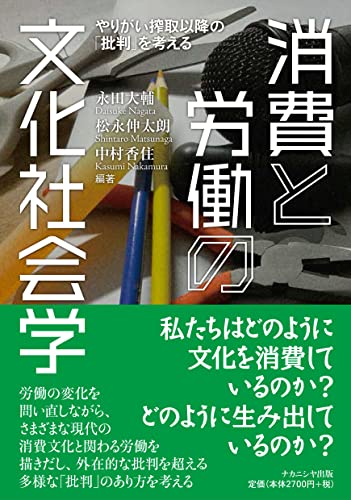5 0 0 0 産業変動の労働社会学 : アニメーターの経験史
- 著者
- 永田大輔 松永伸太朗著
- 出版者
- 晃洋書房
- 巻号頁・発行日
- 2022
- 著者
- 松永 伸太朗 永田 大輔
- 出版者
- 日本社会学会 ; 1950-
- 雑誌
- 社会学評論 = Japanese sociological review (ISSN:00215414)
- 巻号頁・発行日
- vol.71, no.3, pp.358-376, 2020
- 著者
- 永田 大輔
- 出版者
- 日本メディア学会
- 雑誌
- マス・コミュニケーション研究 (ISSN:13411306)
- 巻号頁・発行日
- vol.88, pp.137-155, 2016-01-31 (Released:2017-10-06)
- 参考文献数
- 10
This paper discusses the Video Tape Recorder (VTR) spread process in the 1960s and 1970s. Previous studies on videos have mainly focused on two aspects: (1) sexual media and (2) leisure communities' unique consumption. This paper examines how functions such as slow motion, which were usually used by the leisure communities only were prepared in the first process of family spread. This paper researches the industry paper Video Journal in the period 1968-1978. This industrial magazine has a different focus than that of leisure magazines. This magazine discusses multiple markets in the spread process. This paper will examine each market's demands, according to the industry magazine. From the 1960s to the 1970s the video market was supported by an educational demand. Video was a revolutionary media in audio-visual education. Education has diverse functional needs and feedback regarding these needs can reach the market through study groups. These unique functional demands of leisure groups later spread to family use. In the mid -1970s, Video Journal was conscious of the family market, but its development in this market had been late. First, this may be due to a lack of good content on video. But the true reason is the cost of video recording. Thus, the market could not identify families' needs for a long time, and could not predict the time of family spread. Furthermore, educational needs continued and their demand is left. Both family and educational needs continued and their demand is left. Both family and educational needs did not utilize video functions such as slow motion, which were only used by leisure groups.
4 0 0 0 消費と労働の文化社会学 : やりがい搾取以降の「批判」を考える
- 著者
- 永田大輔 松永伸太朗 中村香住編著
- 出版者
- ナカニシヤ出版
- 巻号頁・発行日
- 2023
4 0 0 0 ビデオのメディア論
- 著者
- 永田大輔 [ほか] 著
- 出版者
- 青弓社
- 巻号頁・発行日
- 2022
- 著者
- 永田 大輔
- 出版者
- ソシオロゴス編集委員会
- 雑誌
- ソシオロゴス (ISSN:02853531)
- 巻号頁・発行日
- no.39, pp.154-173, 2015
- 著者
- 永田 大輔
- 出版者
- 日本マス・コミュニケーション学会
- 雑誌
- マス・コミュニケーション研究 (ISSN:13411306)
- 巻号頁・発行日
- vol.99, pp.209-227, 2021
<p>This paper focuses on content acceptance centered on video in the late 1970s and 1980s. In particular, we will focus on how anime fans, the early adopters of the video format, experienced the content-accepting space.</p><p>In the Japanese literature, there is a certain accumulation for the content receiving space for the anime fans, but It has not yet been discussed in connection with the transformation history of the broader content acceptance space. However, the process of transforming the receptive space of bookstores has grown, and it has become clear over time that this process historically conditions the development of a culture. However, no studies to date have specialized in video acceptance.</p><p>Outside Japan, there has been one study focused on the spatial organization processes of video stores in the United States. In it, the development of video stores is described as a "geography of tastes," and the relationship with the movie industry and the process of forming a receiving space in each region is clarified. However, the study does not clarify for consumers specifically how such a "geography of tastes" was experienced.</p><p>To understand the relationship between anime fans and video, we used anime magazines as resources for this paper. The use of video was positioned differently in the amine fans' groups, depending on the stage of penetration rate. While its rates were low, anime fans' video collections were often exchanged in the informal fan community; however, as video stores became legal, the exchange of videos was discouraged. Therefore, a variety of information about video stores and the characteristics of the community of each video store were posted. Such information also tended to lose its meaning as franchising progressed. The experience history of video-receiving spaces is clarified in this paper, in light of the experiences of anime fans.</p>
- 著者
- 永田 大輔
- 出版者
- 社会学研究会
- 雑誌
- ソシオロジ (ISSN:05841380)
- 巻号頁・発行日
- vol.61, no.3, pp.41-58, 2017-02
- 著者
- 永田 大輔
- 出版者
- 日本マス・コミュニケーション学会
- 雑誌
- マス・コミュニケーション研究 (ISSN:13411306)
- 巻号頁・発行日
- no.88, pp.137-155, 2016-01-31
This paper discusses the Video Tape Recorder (VTR) spread process in the 1960s and 1970s. Previous studies on videos have mainly focused on two aspects: (1) sexual media and (2) leisure communities' unique consumption. This paper examines how functions such as slow motion, which were usually used by the leisure communities only were prepared in the first process of family spread. This paper researches the industry paper Video Journal in the period 1968-1978. This industrial magazine has a different focus than that of leisure magazines. This magazine discusses multiple markets in the spread process. This paper will examine each market's demands, according to the industry magazine. From the 1960s to the 1970s the video market was supported by an educational demand. Video was a revolutionary media in audio-visual education. Education has diverse functional needs and feedback regarding these needs can reach the market through study groups. These unique functional demands of leisure groups later spread to family use. In the mid -1970s, Video Journal was conscious of the family market, but its development in this market had been late. First, this may be due to a lack of good content on video. But the true reason is the cost of video recording. Thus, the market could not identify families' needs for a long time, and could not predict the time of family spread. Furthermore, educational needs continued and their demand is left. Both family and educational needs continued and their demand is left. Both family and educational needs did not utilize video functions such as slow motion, which were only used by leisure groups.
1 0 0 0 OA アニメ産業における制作者のキャリアとジェンダーに関する質的研究
- 著者
- 松永 伸太朗 永田 大輔
- 出版者
- 長野大学
- 雑誌
- 長野大学紀要 = BULLETIN OF NAGANO UNIVERSITY (ISSN:02875438)
- 巻号頁・発行日
- vol.42, no.2, pp.71-72, 2020-11-30
- 著者
- 永田 大輔
- 出版者
- 社会学研究会
- 雑誌
- ソシオロジ (ISSN:05841380)
- 巻号頁・発行日
- vol.59, no.3, pp.21-37, 2015
This paper discussed the process of creating "otaku originality" within thecontext of their consumption. Otaku considered their culture original and distinctfrom that of normal anime consumers in the 1980s. In prior studies, people calledotaku were those committed to worthless culture. Though people regarded otakuculture as worthless, we should observe its formation process. Otaku made ita culture of worth for their community, turning it into a high context culture.Becoming a high context culture meant it achieved interactions with people otherthan anime fans, but how was this happen?This paper focuses on anime fan culture, and discusses the video environmentand active television viewing. The VCR diffusion rate increased from 2.2% to 66.8%during the 1980s. Otaku started to watch videos with their friends. They wantedto show their videos to their friends. However, this was considered an unnaturalbehavior. This paper mainly analyzes community with video consumption amonganime fans and discusses their motivations. They wanted to show off the VCRs"Slowmotioning" meant "unique watching". Originally, anime meant "animation",but their activity enabled anime fans to enjoy "pictures". Consumers could attain"creators literacy". However, this literacy was marketed by the creators. Animemagazines evaluated this marketing. The culture of editing by anime fans formeda frame. They consumed the unique experience of watching anime together asconsumers who had a specific literacy. Otakus' high contextual culture, includingtheir knowledge and literacy, was created by interactions between creators andconsumers of anime magazines.
- 著者
- 永田 大輔
- 出版者
- ソシオロゴス編集委員会
- 雑誌
- ソシオロゴス = Sociologos (ISSN:02853531)
- 巻号頁・発行日
- no.42, pp.84-100, 2018



